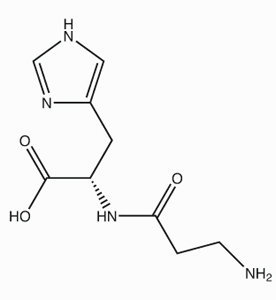Sometimes people seem obsessed with finding the “next” best thing and forget the tried and true. When it comes to supplements, this translates as chasing down the next açaí berry, while abandoning the “older” supplements that really work. This is not hypothetical, but can easily be tracked in the sales of different supplements and in the questions that companies receive, such as: “Why aren’t you using ingredient X in your antioxidant formula?” In the world of natural anti-aging solutions, carnosine is one such ingredient. It was almost 10 years ago that I first started playing with carnosine as an “anti-aging” ingredient and incorporating it in formulas. At that time, the ingredient was almost unknown in the U.S. and Europe, with almost all the research being done in Russia and Australia. Pretty much the only major people incorporating it in formulas at that time were myself and the Life Extension Foundation.
Within a couple of years, however, carnosine was appearing everywhere: in supplements, eye drops, and skin creams — all promoting its anti-aging benefits. And for awhile, people bought lots of it. But then three things happened.
- Much of the carnosine being used was very low grade — pure crap, to put it in technical terms. It wasn’t very effective. The good stuff cost substantially more and was harder to get. That meant that the “carnosine” products from a lot of companies simply didn’t do anything.
- It was an expensive ingredient when it first came out so much of it was used at pixie dust levels, purely as label dressing — so companies could claim they had it in their products. Unfortunately, that meant it had virtually no effect, and people eventually stopped buying these products. This severely tarnished carnosine’s reputation as an effective anti-aging ingredient. The problem is that carnosine’s effectiveness doesn’t just build gradually. If you don’t take enough of it during the day, it simply has no effect. The reason is that carnosine is readily degraded by the enzyme carnosinase in the human body. You need to take enough to overwhelm the carnosinase so that “undegraded” carnosine can make its way to the cells of your body. The amount varies according to age and diet, but in general, for people in their mid-thirties and higher, you’re looking at 1000-1500 mg a day. If you’re younger, healthy, and include lots of meat in your diet, 500 mg a day is probably enough. But less than that, and you might as well be taking sugar pills.
- And as it turns out, people have short memories. Other anti-aging solutions began to appear in the news — ingredients such as growth hormone and resveratrol that pushed carnosine out of the news. At that point, no one was looking for carnosine products for anti-aging. That was “old fashioned,” like Carter’s Little Liver Pills. They were looking for resveratrol and açaí berry. And suddenly you had resveratrol and açaí supplements and skin care products flooding the market. Carnosine was nowhere to be found. (Incidentally, I have nothing against either resveratrol or açaí. I was using resveratrol in my antioxidant formulas back in 1999, years before it became “hot.” As for açaí, I introduced it to the Health Sciences Institute for a feature story in 2003, long before Dr. Perricone promoted it on Oprah.)
And that’s where things stood with carnosine until Dr. Oz “discovered” it last year (about ten years behind the curve) and made it “hot” once again — at least for awhile. Unfortunately, because the quality of much of the carnosine out there is still suspect and because many companies are still using it as label dressing, it once again failed to produce as advertised and once again faded from the news. And that’s a shame!
Why?
Because, even though it’s “yesterday’s news” and no longer trendy, carnosine, when used properly, is one of the most effective and fast acting natural anti-aging options available — and that’s being confirmed and validated in study after study. And quite simply, there is probably no other supplement you can easily take without a doctor monitoring you, that will produce a faster change in your appearance!
With that in mind, let’s take a fresh look at carnosine — what we knew ten years ago when I first wrote about it and used it in formulas, and what we now know as the result of the most recent studies.
Carnosine 10 years ago

Most notably, there were a series of astonishing experiments done in Australia that proved that carnosine rejuvenates cells as they approach senescence (the stage just before death where a cell is still alive, but essentially non-functional). The studies showed that cells cultured with carnosine lived longer and retained their youthful appearance and growth patterns.
What’s probably the most exciting result of the studies is that it was discovered that carnosine can actuallyreversethe signs of aging in senescent cells.
How to ReverseAging in Cells
In one study, when scientists transferred senescent cells to a culture medium containing carnosine, those cells exhibited a rejuvenated appearance and often an enhanced capacity to divide.1,2When they transferred the cells back to a medium lacking carnosine, the signs of senescence quickly reappeared.
As they switched the cells back and forth several times between the culture media, they consistently observed that the carnosine medium restored the juvenile cell phenotypewithin days, whereas the standard culture medium brought back the senescent cell phenotype. In addition, the carnosine medium increased cell life span — even for old cells. When the researchers took old cells that had already gone through 55 divisions and transferred them to the carnosine medium, they survived up to 70 divisions, compared to only 57 to 61 divisions for the cells that were not transferred.
This represents an increase in the number of cell divisions for each cell of almost 25%.
But in terms of cell life, the increase was an astounding 300%. The cells transferred to the carnosine medium attained a life span of 413 days, compared to just 126 to 139 days for the control cells.
Increase Life Expectancy
A Russian study on mice subsequently showed that mice given carnosine are twice as likely to reach their maximum lifespan as untreated mice.3,4Carnosine also significantly reduces the outward “signs of old age.”
In effect, it makes the mice look younger. 44% of the carnosine treated mice had young, glossy coats in old age as opposed to only 5% in the untreated mice. This represents 900% better odds of looking young in old age.
Another important difference between the treated and the untreated mice was in their behavior. Only 9% of the untreated mice behaved youthfully in old age, versus 58% of the carnosine treated mice. That’s a 600% improvement in how they felt.
Protein Glycation: Sugar and Aging

Your body is mostly made up of proteins. In fact, proteins are the substances most responsible for the daily functioning of your body. That’s why anything that causes protein deterioration has such a dramatic impact on the body’s function and appearance.
Thanks largely to the destructive effect of sugar and aldehydes (compounds formed by the oxidation of alcohol), the protein in our bodies tends to undergo destructive changes as we age. This destruction is a prime factor, not only in the aging process itself, but also in the familiar signs of aging such as wrinkling skin, cataracts, and the destruction of our nervous system — particularly our brains. Studies show that carnosine is effective against all these forms of protein modification.
Protein Modification for Longevity
As I said, aging is associated with damage to cellular proteins. But carnosine protects cellular proteins from damage in at least two ways.
- Carnosine bonds with the carbonyl (or aldehyde) groups that if left alone will attack and bind with proteins.5,5
- It works as an antioxidant to prevent the formation of oxidized sugars, also called Advanced Glycosylation End-products or AGEs for short. That’s really the caramelization thing that I mentioned earlier. The bottom line here is that the less AGEs, in your body, the younger you are.6,7
Both of these processes have important implications for anti-aging therapy. The key is that carnosine not only prevents damaging cross-links from forming, it eliminates cross-links that have previously formed in proteins, thus restoring normal membrane function in cells.
Preventing Alzheimer’s
Carnosine has been proven to reduce or completely prevent cell damage caused by beta-amyloid (AKA amyloid-beta, amyloid ß-protein, and Aß), one of the prime suspected protein risk factors for Alzheimer’s. The presence of beta-amyloid leads to damage of the nerves and arteries of the brain. Carnosine blocks and inactivates beta-amyloid.8In effect, it protects neural tissues against dementia. The key is that carnosine not only prevents damaging cross-links from forming in proteins, it eliminates cross-links that have previously formed in those proteins, thus restoring normal membrane function in cells. This is true not only in the brain, but in all the organs of our body — our skin included. Keep in mind that the damage you see in the skin is not just a cosmetic question. That damage is absolutely an indicator of the kinds of damage happening to every other organ in your body — including your eyes and your brain.
It should be noted that although still “unproven,” the beta-amyloid connection to Alzheimer’s is nevertheless the dominant theory as to its primary cause. The mainstay of the amyloid ß-protein hypothesis of Alzheimer’s disease is that a gradual and chronic imbalance in the production versus the clearance of Aß leads to a slow rise in its steady state levels in brain tissue. This leads to beta-amyloid plaque accumulation and subsequently, to the complex molecular and cellular changes associated with the disease.9Thus anything that helps inhibit excess beta-amyloid accumulation in the brain — or even better, helps remove it — is likely to be Alzheimer’s protective.
Auto-Regulator
Carnosine has the remarkable ability to throttle down bodily processes that are in a state of excess, and to ramp up those that are under expressed. For example, carnosine thins the blood of people whose blood tends to clot too much and increases the clotting tendency in those with a low clotting index.10
Another example is that carnosine suppresses excess immune responses in those who have “hyper” immune systems, whereas it stimulates the immune response in those with weakened immune systems — such as the aged.11This is a critical benefit for people with allergies and people with autoimmune disorders.
And, as a neurotransmitter,carnosine even seems to have the ability to normalize brain wave functions.12In fact, studies indicate that carnosine might play an invaluable rolein helping to prevent and control seizures.13
Carnosine — the New Studies
And that’s where things stood when I first wrote about carnosine ten years ago. Since then, the evidence of carnosine’s benefits has continued to pour in. For example, a 2010 study published inRejuvenation Researchfound that adding carnosine to the diet of fruit flies produced a 20% increase in the average life span of male flies.14Curiously, it had no effect on the lifespan of female flies — until water-soluble vitamin E was also added. At that point, female flies experienced an immediate 36% increase in longevity. Although fruit flies are not human beings, this study confirms observations already seen in human subjects. Note: the reason for using fruit flies as test subjects is that their short lifespan allows for quick observation on whether a nutrient increases lifespan or not. By itself, this study may not mean a lot, but when analyzed in the context of the following studies, it’s extremely powerful.
Carnosine helps control blood glucose

The bottom line is that in addition to its life extension benefits, L-carnosine is beginning to emerge as an indispensible supplement for diabetics. It not only helps control primary factors in the onset of diabetes, but it also protects againstdiabetic echo effectssuch as organ protein degradation, loss of kidney function,17,18damage to the eyes,19neuropathy,20and cardiovascular damage21,22— not to mention actually helping the heart muscle contract more efficiently.23
Carnosine Helps with Wound healing
In a study published just last month, treatment with L-carnosine enhanced wound healing significantly. In addition, wound tissue analysis showed increased expression of growth factors and cytokines genes involved in wound healing.24And even further, in vitro analysis of human dermal fibroblasts (the cells that promote skin healing) and microvascular-endothelial cells (the cells responsible for regenerating new blood vessels after injury) showed that carnosine increases cell viability in the presence of high glucose. But this is not only important for diabetics. In fact, wound care for the elderly in long term and acute care facilities is often extremely difficult — not to mention very costly for the facilities involved. Again, the connection between seniors in general and people with diabetes is the dramatically lower levels of carnosine in their cells shared by both groups. In other words, the benefits in wound healing experienced by diabetic patients is likely to be seen by the general senior population as well.
Carnosine Protects Against the Side Effects of Chemotherapy

In addition, cancer researchers are starting to identify how carnosine’s antioxidant and anti-inflammatory capabilities may not only play a chemoprotective role, but actually help protect against cancer itself. How? First, as just mentioned in the paragraph above, carnosine helps block DNA damage that can lead to transformation of healthy cells into malignant cells.26In addition, it has demonstrated a significant ability to both inhibit tumor growth27as well as the metastasis of existing cancers.28
Carnosine Protects Against Alcohol Induced Liver Damage
In yet another confirmation of carnosine’s ability to protect against damages from excess levels of sugar and alcohol in the bloodstream, a study published in the June issue ofToxicology and Industrial Healthhas shown that supplementation with carnosine is effective for both preventing and repairing biochemical alterations and morphologic damage in the liver caused by exposure to alcohol.29In other words, regular supplementation with carnosine might be worth considering if you’re prone to regularly party down.
Carnosine Protects Your Brain
Two facts lend more credence to the idea that supplemental carnosine is beneficial to your brain. First, it has been known for some time that brain tissue naturally contains high levels of carnosine, which are capable of reducing the oxidative and glycemic stresses to which the brain is especially vulnerable.30Carnosine in brain tissue reduces inflammation, a harmful factor in and of itself,31and as we’ve already discussed, carnosine reduces the accumulation of beta-amyloid plaque in the brain, a probable key factor in the onset of Alzheimer’s. And of course, as I discussed 10 years ago, carnosine is an effective heavy metal chelator that crosses the blood-brain barrier and thus can help reduce the toxic impact of heavy metals that may accumulate in the brain.32
The second key fact is that more recent studies have shown that carnosine levels are actually significantly lower in patients with Alzheimer’s and other neurodegenerative disorders such as Parkinson’s disease than in people without those problems.33This might indicate either a carnosine deficiency that allows for the onset of the diseases (remember that carnosine levels are dramatically lower in pre-diabetics, diabetics, and the elderly) or that the diseases themselves exhaust the carnosine supplies in the brain. Or both together! Either way, numerous studies now point to the role carnosine might play in both protectingthe brain from Alzheimer’s and even Parkinson’s disease, for that matter.34,35Even more exciting, sufficient supplementation with carnosine may even play a role in helping to reverse at least some of that damage.
Conclusion
Make no mistake; L-carnosine may no longer be “new” news. And it may no longer be trendy; but it still ranks as one of the most important anti-aging supplements available to us today. Not only is it protective for all of the long-term conditions mentioned above, but it is probably the single supplement most likely to produce a visible “youthening” of your appearance in the shortest possible time — three to six months.
The following may not be scientific proof, but it is worth considering. I’m turning 65 in February, and my sister still calls me Peter Pan. In fact, even though she’s five years younger than I am, she always introduces me as her younger brother — to avoid questions. I’ve been supplementing with 1,500 mg of carnosine a day (using my own formulas) for 10 years now. My skin looks years younger than my age. Neither my sister nor any of my other siblings supplement with carnosine. They don’t look the same, so we’re not talking genetics here.
It may not be scientific, double-blind-study proof — but I’m just sayin!
Note: I still recommend usinga carnosine formulasimilar to the one I put together ten years ago that also includes DMAE and Acetyl-l-carnitine to help remove the lipofuscin produced in the body as a side effect of carnosine’s protective action. Over the years, I’ve tweaked and refined the ratios of the ingredients in the formula based on hands on results, but its essence has remained unchanged…because it works.



'Carnosine, Still the Best for Anti-Aging' has no comments
Be the first to comment this post!